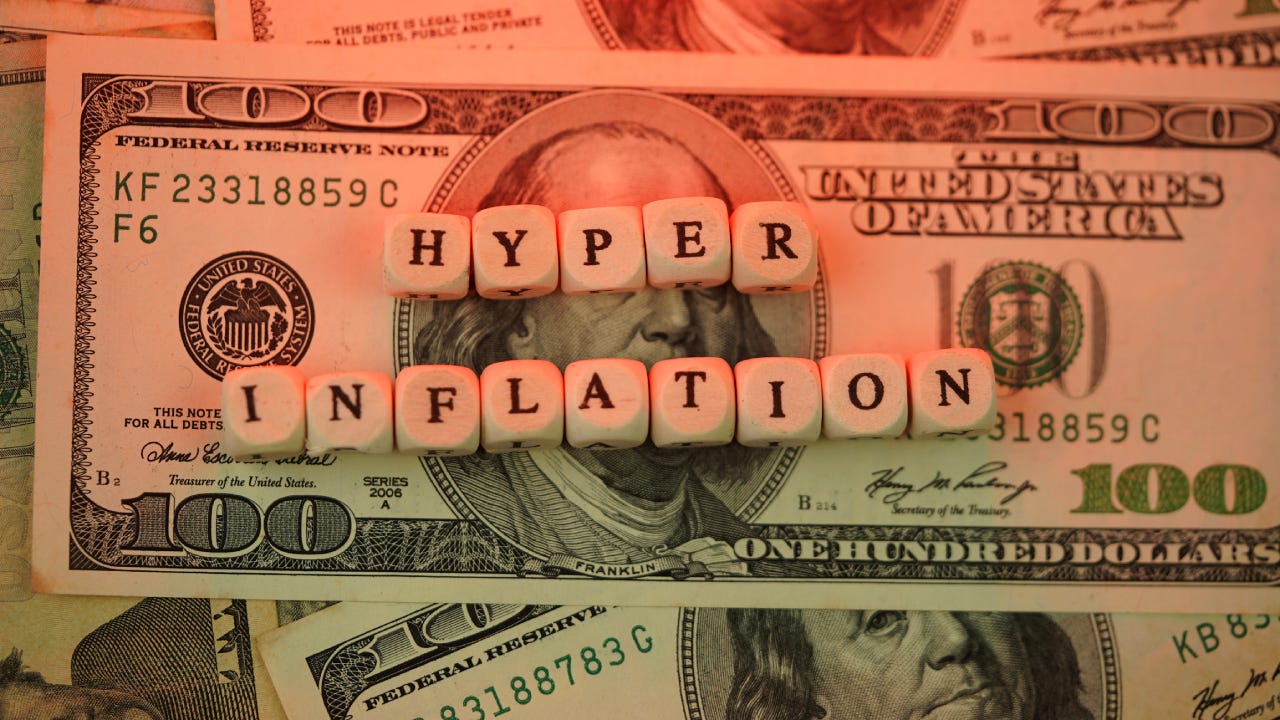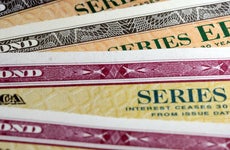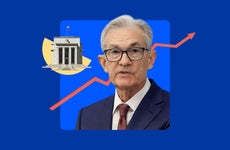What is hyperinflation?

The Bankrate promise
At Bankrate we strive to help you make smarter financial decisions. While we adhere to strict , this post may contain references to products from our partners. Here's an explanation for .
Our writers and editors used an in-house natural language generation platform to assist with portions of this article, allowing them to focus on adding information that is uniquely helpful. The article was reviewed, fact-checked and edited by our editorial staff prior to publication.
Hyperinflation is a severe form of inflation, which is the widespread increase in prices on goods and services. What differentiates hyperinflation from inflation is the rate and the causes. Hyperinflation is sometimes defined as inflation greater than 50 percent per month, in comparison with typical inflation in a developed country of 1 to 4 percent annually. The result of hyperinflation is like those classic images of consumers trucking cartloads of cash to buy groceries in 1920s Germany.
Here’s what causes hyperinflation, the signs of it and what you can do to protect yourself.
What causes hyperinflation?
Inflation can be caused by a variety of factors — increased money supply, too much demand, decreased supply, rising input prices and price gouging, among others — and it’s normal to have some inflation as an economy grows. But the conditions for hyperinflation are more specific:
- A country runs up significant debts, especially debts denominated in foreign currencies.
- The country’s productive capacity becomes impaired somehow, hurting both the government’s ability to collect tax revenue and the country’s exchange rate.
- The cost of foreign debt rises (due to a falling exchange rate), and the government can’t collect enough in taxes to meet its expenses and can’t borrow to make up the difference, perhaps due to a crisis in confidence from political or economic chaos.
- The government turns to printing money to pay its bills, the exchange rate collapses and debts spiral out of control.
A vicious cycle reinforces the process. As the value of money declines, the government must print more to keep up with expenses, leading to even higher inflation — and finally, hyperinflation. Consumers realize their money will be worth more if they spend it now rather than hoard it for later, pushing up inflation more.
What are the signs of impending hyperinflation?
Economists and financial experts recognize several signs of looming hyperinflation.
Rapid increase in inflation: Economists consider inflation exceeding 5 percent as high. If this rate surpasses 50 percent per month, it is deemed hyperinflation. A rapid escalation of inflation, especially without corresponding real economic growth, can be a warning sign for hyperinflation.
Loss of confidence in government institutions: When the public loses faith in its government’s ability to manage economic and financial crises, including faith in its country’s currency, hyperinflation may be on the horizon. It’s important to factor in foreigners’ loss of confidence in a country, especially foreign investors, who might otherwise lend to the country. Their unwillingness to lend at any rate helps precipitate hyperinflation.
Rising debts: A rising debt helps put pressure on the government by creating a further source of financial strain. It can be particularly troublesome if the debt is denominated in a foreign currency, since every decline in the exchange rate makes it more expensive to service.
Collapsing exchange rate: Another part of the equation for hyperinflation is a gradually declining and then collapsing exchange rate, as international investors lose confidence in the country. The collapsing exchange rate makes foreign-denominated debt unpayable.
Inability of a government to borrow: If the government is unable to borrow, especially in its own currency, it may have no other recourse but to print money to pay its bills.
Rapid increase in money supply: If the money supply grows rapidly without being backed by an increase in real growth, it can lead to hyperinflation. This scenario often occurs when governments print money excessively. A recent example of rampant money printing and hyperinflation is Venezuela.
How does hyperinflation differ from high inflation and stagflation?
While all three terms — hyperinflation, high inflation and stagflation — denote negative economic conditions, they are distinct in their impact and frequency. High inflation, for example, can make it difficult to afford everyday essentials, but the cycle is relatively easier to break than hyperinflation.
- Hyperinflation is an extreme state of inflation resulting from severe currency devaluation, soaring debt, loss of confidence in the country and government printing of money.
- High inflation is less severe, though it also involves price increases. High inflation can generally be curbed by reducing the money supply through higher interest rates or reducing aggregate demand.
- Stagflation combines high inflation with stagnant economic growth and high unemployment, marking an unhealthy economic scenario.
How does hyperinflation impact the economy and individuals?
At a macro level, hyperinflation can severely hinder a country’s ability to meet its financial obligations or produce goods and services. The price of goods skyrockets, making it difficult for consumers to afford basic essentials and businesses to make a profit. Meanwhile, prices can change so quickly that it becomes difficult to plan and operate. The exchange rate plummets, making the country’s products cheap for foreigners, and making any foreign goods or inputs prohibitively expensive to import.
On an individual level, it also becomes prohibitively expensive to buy anything produced outside the country and citizens are left to buy only locally made products. Ultimately, citizens’ standard of living will be destroyed, with widespread poverty.
How can hyperinflation be controlled or stopped?
Controlling or halting hyperinflation requires a multi-faceted strategy. In general, the country must wipe the slate clean, establishing a new and credible basis for financial transactions.
One of the first steps for recovering from hyperinflation is to establish a new currency. That currency could be a new version of the existing currency, a credible foreign currency such as the U.S. dollar or pegging the currency against another benchmark such as gold.
Using a foreign currency or another benchmark keeps the government from printing money, helping to rein in its spending. This approach also helps re-establish the government’s credibility as a prudent spender, and may convince foreign investors to lend money to the country.
If the government introduces a new currency, it must be a credible alternative to the existing currency, meaning the currency’s potential users must believe that the government will not simply do the same thing that it did to the old currency. Often for a new currency to work, a new government must be established that can make credible promises to foreign investors.
After a credible new currency is established, the country can begin the process of rebuilding its standard of living through the productive assets that it has available.
What measures can the Federal Reserve take to prevent hyperinflation?
In the U.S., the Federal Reserve plays a crucial role in keeping prices stable, and the disastrous economic consequences of hyperinflation is one reason why. Officials judge a little bit of inflation as a feature of a sustainable and productive economy, with 2 percent typically the goldilocks, “not-too-hot, not-too-cold” rate.
The Fed controls inflation in a few main ways:
- Adjusting interest rates: To slow inflation, the Fed can raise its key benchmark interest rate that acts as a direct lever on the borrowing costs consumers pay to finance cars and homes or items on a credit card. Higher interest rates are thought to weigh on demand and consumer spending, and they also end up shrinking the availability of credit in the economy as financial firms lend out less money.
- Regulating the money supply: To vacuum out the amount of money sloshing around in the economy, the Fed can shrink banks’ reserves balances.
- Establishing confidence in U.S. monetary policy: By talking tough on inflation and establishing a pattern of backing up words with actions, the central bank can help investors and consumers retain their belief in U.S. price stability — an expectation that often becomes reality.
- Undertaking actions that maintain employment: Keeping the U.S. economy productive can boost growth and ensure Americans have stable income that can be taxed for government revenue.
While the Fed can help the U.S. avoid hyperinflation through monetary policy, the government can pursue fiscal policies that thwart the central bank’s policies. For example, the government can spend much more than it takes in and then refuse to raise taxes (perhaps due to political gridlock) or cut spending. Such ongoing gridlock could ultimately lead to a loss of confidence in U.S. financial institutions and work against the Fed’s inflation-fighting policies.
How can you protect yourself from hyperinflation?
Individuals can adopt several strategies to safeguard their finances during hyperinflation. At their core these strategies rely on getting money safely invested in stable foreign economic regimes, because a key aspect of hyperinflation is a rapid devaluation of the domestic currency.
- Buy foreign stocks: Buying stock in productive foreign companies gets your capital working and producing income.
- Buy foreign real estate: Foreign real estate in a stable area can retain value regardless of what happens in the hyperinflationary environment. Publicly traded real estate investment trusts (REITs) that hold assets in foreign countries are a quick way to safeguard money from a hyperinflationary environment.
- Buy gold: Gold can act as a store of value and a kind of international currency, and it can be among the fastest ways to quickly tie your capital to a source of value outside your country. It’s easy to buy a gold ETF that tracks the price of gold, but bullion is a much less attractive way to do it.
In short, those with investable assets should look to get them out of the quickly devaluing currency as soon as possible so that they retain as much value as possible.
Bottom line
Hyperinflation can quickly erode the value of a country’s currency and lead to unaffordable prices for everyday necessities. But it’s important to understand that it takes a specific set of conditions and a long road of missteps for a country to make this drastic error.
Related Articles




What is the federal funds rate? How the Fed controls interest rates, explained